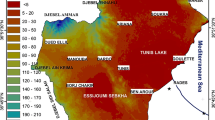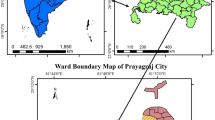Abstract
The risk of water utilities would include the water quality failure and the water quantity failure, from the source to the tap, including the catchment, treatment, distribution and the customer plumbing system. In this paper, we proposed a practical evaluation method based on the analytic hierarchy process (AHP). The hierarchical structure of the water utilities was established in terms of the fault event analysis from the past failure accidents. The severity of criteria was preset by the experts and the probability of criteria was determined by a modified CUWA-TSM sheet with the consideration of the actual situations of the supply system. The evaluation model was successfully performed by a case study. Although, the method in this paper may not be as good as the framework of WSPs, it has a great advantage compared to WSPs and TSM. The risk management can be applied through specific software packages with a user-friendly interface, which means it is easier to implement. In addition, it can point out the critical control points (CCPs) for the decision-makers. So we believe this method will improve and play a more and more active role in the development of the risk management in China water works.
Similar content being viewed by others
References
Ministry of Health, People’s Republic of China, Standard for drinking water quality (GB5749-2006), 2006 (in Chinese)
China Statistic Yearbook 2008, Beijing: China Statistics Press, 2009 (In Chinese)
China Statistic Yearbook 2009, Beijing: China Statistics Press, 2010 (in Chinese)
Qian Y. Current status of research on water pollution control in China. In: Proceedings of 3rd IWA-ASPIRE conference and exhibition. Taipei, 2009
Zhang X J, Chen C, Lin P F, Hou A X, Niu Z B, Wang J. Emergency drinking water treatment during source water pollution accidents in China: origin analysis, framework and technologies. Environmental Science & Technology, 2011, 45(1): 161–167
Zhang X J, Chen C, Ding J Q, Hou A, Li Y, Niu Z B, Su X Y, Xu Y J, Laws E A. The 2007 water crisis in Wuxi, China: analysis of the origin. Journal of Hazardous Materials, 2010, 182(1–3): 130–135
WHO (World Health Organization). Guidelines for drinking water quality, Vol 1. Geneva: World Health Organization, 2004
Cox L A Jr. What’s wrong with risk matrices? Risk Analysis, 2008, 28(2): 497–512
Hamilton P D, Gale P, Pollard S J T. A commentary on recent water safety initiatives in the context of water utility risk management. Environment International, 2006, 32(8): 958–966
Mullenger J, Rayn G, Hearn J. A water authority’s experience with HACCP. Water Science and Technology: Water Supply, 2002, 2(5–6): 149–155
Lindhe A, Rosén L, Norberg T, Bergstedt O. Fault tree analysis for integrated and probabilistic risk analysis of drinking water systems. Water Research, 2009, 43(6): 1641–1653
CDW/CCME. From source to tap: guidance on the multi-barrier approach to safe drinking water. Federal-provincial-territorial committee on drinking water and Canadian council of ministers of the environment water quality task group, Health Canada, 2004
China urban water association. Water supply technique safety management system checklist, 2009 (http://www.cuwa.org.cn/xhtzh/xhtzh/21013.shtml, accessed by 27 Sept., 2011)
Saaty T L. The analytic hierarchy process. New York: McGraw-Hill, 1980
Delgado-Galván X, Rafael Pérez-García R, Izquierdo J, Mora-Rodríguez J. An analytic hierarchy process for assessing externalities in water leakage management. Mathematical and Computer Modelling, 2010, 52(7–8): 1194–1202
Lee D J, Hwang J. Decision support for selecting exportable nuclear technology using the analytic hierarchy process: a Korean case. Energy Policy, 2010, 38(1): 161–167
Xu G, Yang Y, Lu S, Li L, Song X. Comprehensive evaluation of coal-fired power plants based on grey relational analysis and analytic hierarchy process. Energy Policy, 2011, 39(5): 2343–2351
Bottero M, Comino E, Riggio V. Application of the analytic hierarchy process and the analytic network process for the assessment of different wastewater treatment systems. Environmental Modelling & Software, 2011, 26(10): 1211–1224
Chang N B, Chang Y H, Chen H W. Fair fund distribution for a municipal incinerator using GIS-based fuzzy analytic hierarchy process. Journal of Environmental Management, 2009, 90(1): 441–454
Dey P K, Ramcharan E K. Analytic hierarchy process helps select site for limestone quarry expansion in Barbados. Journal of Environmental Management, 2008, 88(4): 1384–1395
Gray N F. Water Technology: an introduction for environmental scientists and engineers. 2nd ed. Oxford: Elsevier Butterworth-Heinemann, 2005
Author information
Authors and Affiliations
Corresponding author
Rights and permissions
About this article
Cite this article
Chen, H., Xiao, F., Bi, Z. et al. Practical evaluation for water utilities in China by using analytic hierarchy process. Front. Environ. Sci. Eng. 9, 131–137 (2015). https://doi.org/10.1007/s11783-014-0718-1
Received:
Accepted:
Published:
Issue Date:
DOI: https://doi.org/10.1007/s11783-014-0718-1




